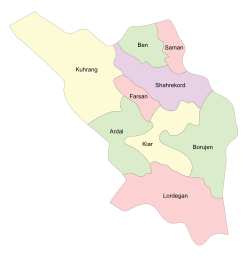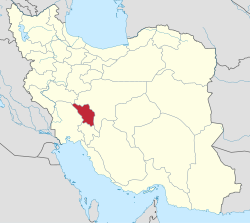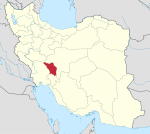محافظة جهارمحال وبختياري
Chahar Mahaal and Bakhtiari Province
استان چهارمحال و بختیاری | |
|---|---|
 Counties of Chaharmahal and Bakhtiari Province | |
 Location of Chaharmahal and Bakhtiari Province in Iran | |
| الإحداثيات: 32°19′39″N 50°51′17″E / 32.3275°N 50.8546°E | |
| Country | |
| Region | Region 2 [1] |
| Capital | Shahrekord |
| Counties | 9 |
| الحكومة | |
| • Governor | Eghbal Abasi |
| المساحة | |
| • الإجمالي | 16٬332 كم² (6٬306 ميل²) |
| التعداد (2016)[2] | |
| • الإجمالي | 947٬763 |
| • الكثافة | 58/km2 (150/sq mi) |
| منطقة التوقيت | UTC+03:30 (IRST) |
| • الصيف (التوقيت الصيفي) | UTC+04:30 (IRST) |
| Main language(s) | Bakhtiari Lurish Persian |
| HDI (2017) | 0.798[3] high · 13th |
محافظة تشهار محال وبختیاري (بالفارسية استان چهارمحال وبختیاری) هي إحدى محافظات إيران الإحدی والثلاثين، وتقع في جنوب غرب إيران بمساحة 16,332 كيلومتر مربع. وعاصمتها شهر كرد، أي مدينة الأكراد. ويسكنها القبائل البختيارية من القومية الكردية. وفي تعداد 2006 فقد بلغ تعداد المحافظة 843,784 نسمة في 194,171 عائلة.[4] وفي التعداد التالي 2011 أحصى 895,263 نسمة في 234,416 عائلة.[5] By the time the 2016 census was conducted, the province's population had risen to 947,763 in 270,434 households.[6]
المحافظة مصنفة كجزء من المنطقة 2 حسب تقسيم المحافظات إلى خمس مناطق فقط لأغراض التنسيق والتنمية في 22 يونيو 2014.[1]
التقسيمات الإدارية
| الخريطة | المقاطعة | بخش | مركز البخش |
|---|---|---|---|
| أردل | المركزي | أردل | |
| ميانكوه | سرخون | ||
| بروجن | مركزي | بروجن | |
| بلداجي | بلداجي | ||
| گندمان | گندمان | ||
| فارسان | المركزي | فارسان | |
| كوهرنگ | المركزي | چلگرد | |
| بازفت | چمن گلي | ||
| كيار | المركزي | شلمزار | |
| ناغان | ناغان | ||
| لردگان | المركزي | لردگان | |
| فلارد | مال خليفه | ||
| خانميرزا | آلوني | ||
| منج | منج | ||
| شهركرد | مركزي | شهركرد | |
| بن | بن | ||
| لاران | سورشجان | ||
| سامان | سامان |
المدن
According to the 2016 census, 607,444 people (over 64% of the population of Chaharmahal and Bakhtiari province) live in the following cities: Aluni 5,248, Ardal 10,113, Babaheydar 11,202, Bazoft 1,519, Ben 12,971, Boldaji 11,980, Borujen 57,071, Chelgerd 2,989, Cholicheh 4,945, Dashtak 4,016, Dastana 5,143, Faradonbeh 13,317, Farrokh Shahr 31,739, Farsan 30,504, Gahru 6,263, Gandoman 6,291, Gujan 6,179, Hafshejan 21,352, Haruni 3,601, Junqan 14,433, Kaj 4,227, Kian 12,948, Lordegan 40,528, Mal-e Khalifeh 4,024, Manj 1,492, Nafech 4,059, Naghan 6,125, Naqneh 9,923, Pardanjan 8,699, Saman 14,192, Samsami 1,203, Sar Khun 2,131, Sardasht 5,691, Sefiddasht 5,471, Shahr-e Kord 190,441, Shalamzar 6,899, Sudjan 5,581, Sureshjan 12,308, Taqanak 6,170, and Vardanjan 4,456.[6]
اللغات
Bakhtiāri, which belongs to the Luri language of the Iranian language family, is the province's main language. Bakhtiāri is primarily spoken in the valleys of the higher areas in the western half of the province. It is also spoken in the lower areas around Lordegān in the south, and by speakers who have moved into the cities in the north-east.[7]
In the north-east quarter of the province, people in most cities and villages speak either Chārmahāli (also in the Southwestern branch of Iranian) or Chaharmahali Turkic. Chārmahāli is transitional between Bakhtiari and Persian varieties of Isfahan province, but more similar to the latter. Chārmahāli varieties spoken in cities include Dehkordi (in Shahr-e Kord), Ghafarrokhi (in Farrokh Shahr), Heysheguni (in Hafshejān), and Borujeni (in Borujen). There are also many other varieties of Chārmahāli spoken in rural areas. Most types of Turkic spoken in this province are similar to Qashqa’i of Fars province, but they are transitional to the Āzarbāyjāni (Azerbaijani) language of north-west Iran. The Chārmahāli and Turkic language areas overlap with one another, and in the foothills of the Zagros and in the larger cities, they intermingle with Bakhtiāri as well.[7]
Tehrani-type Persian is now being taught by parents to children as a first language in some parts of the province, with the highest concentrations in the cities.[7]
The Atlas of the Languages of Iran (ALI) published a series of language maps for Chahar Mahal and Bakhtiari province, including a point-based and polygon (area-based) language distribution maps, and several linguistic data maps.[7]
Written descriptions of some of the Bakhtiāri varieties in the province.[9][10] and a lexicon of the Bakhtiāri language[11] have also been published.
الاقتصاد
The province is mainly active in the agriculture sector. Most of the industrial sector is clustered around the center of the province.
The province has the potential to become a vibrant tourist attraction because of its natural resources.[12]
المعالم الطبيعية
Chaharmahal and Bakhtiari province is the source and birthplace of many springs, rivers and waterfalls that supply the water of the two great and vital rivers of Zayanderud and Karoon and cause the development of many cities in the country. Natural attractions include Zayanderud river, Zamankhan bridge, Kouhrang 1 Dam, Dime spring, Sheik Ali Khan waterfall, Chama Ice cave, Darkesh varkesh canyon, Rostam Abad Sardab spring, Do Polan, Karoon-4 dam, Darreh Esgh (love valley), Atashgah waterfall, Choghakhor Wetland, Pire Ghar cave, Siasard spring, Helen protected area, Barm spring, Sendegan spring, Tang Sayyad national Park, Parvaz national park, Sarab cave, Gandoman wetland, Zard lime waterfall, Kordikon waterfall.[13]
الكليات والجامعات
- Islamic Azad University of Borujen
- Islamic Azad University, Shahrekord Branch[14]
- جامعة شهركرد
- جامعة شهركرد للعلوم الطبية
المصادر
- ^ أ ب "استانهای کشور به ۵ منطقه تقسیم شدند". همشهری آنلاین. June 22, 2014. Retrieved July 21, 2019.
- ^ "National census 2016". amar.org.ir. Retrieved 2017-03-14.[]
- ^ "Sub-national HDI - Area Database - Global Data Lab". hdi.globaldatalab.org (in الإنجليزية). Retrieved 2018-09-13.
- ^ "Census of the Islamic Republic of Iran, 1385 (2006)". AMAR (in الفارسية). The Statistical Center of Iran. p. 14. Archived from the original (Excel) on 20 September 2011. Retrieved 25 September 2022.
- ^ "Census of the Islamic Republic of Iran, 1390 (2011)" (Excel). Iran Data Portal (in الفارسية). The Statistical Center of Iran. p. 14. Retrieved 19 December 2022.
- ^ أ ب "Census of the Islamic Republic of Iran, 1395 (2016)". AMAR (in الفارسية). The Statistical Center of Iran. p. 14. Archived from the original (Excel) on 24 May 2019. Retrieved 19 December 2022.
- ^ أ ب ت ث "Language distribution: Chahar Mahal va Bakhtiari Province". Iran Atlas. Archived from the original on 2017-12-05. Retrieved 10 January 2022.
- ^ "Language distribution: Chahr Mahal va Bakhtiari Province". 2020. Retrieved 11 April 2022.
- ^ Khosravi, Abdol’ali. 1996/1375. Guyesh-e Bakhtiāri: Ketāb-e chahārom [Bakhtiari dialect: Fourth book]. Esfahan: Nashr-e Ghazal.
- ^ Tāheri, Esfandyār. 2010/1389. Guyesh-e Bakhtiāri-ye Kuhrang [The Bakhtiari dialect of Kuhrang]. Tehran: IHCS Press.
- ^ Madadi, Zohrāb. 1996/1375. Vāzhehnāmeh-ye zabān-e Bakhtiāri [Lexicon of the Bakhtiari language]. Tehran & Esfahan: Enteshārāt-e Āyāt.
- ^ "Choghakhor to become a tourist hub by 2008". www.payvand.com. Archived from the original on September 26, 2011. Retrieved July 21, 2019.
- ^ "A trip to Chaharmahal and Bakhtiari".
- ^ "Islamic Azad University Shahrekord Branch - About Shahrekord". August 15, 2011. Archived from the original on August 15, 2011. Retrieved July 21, 2019.



